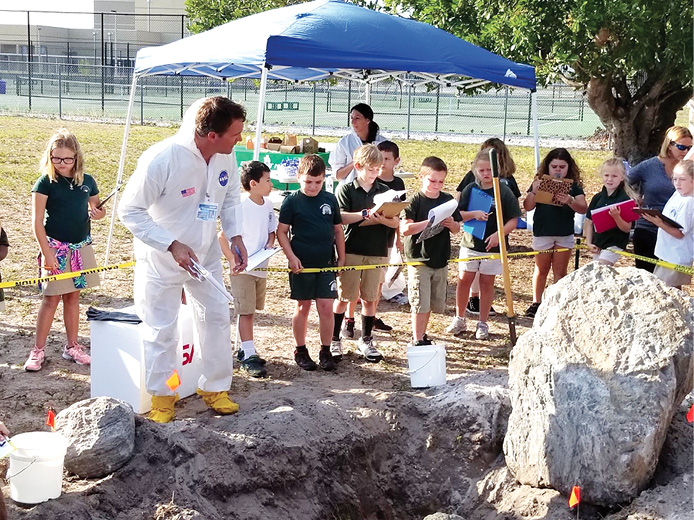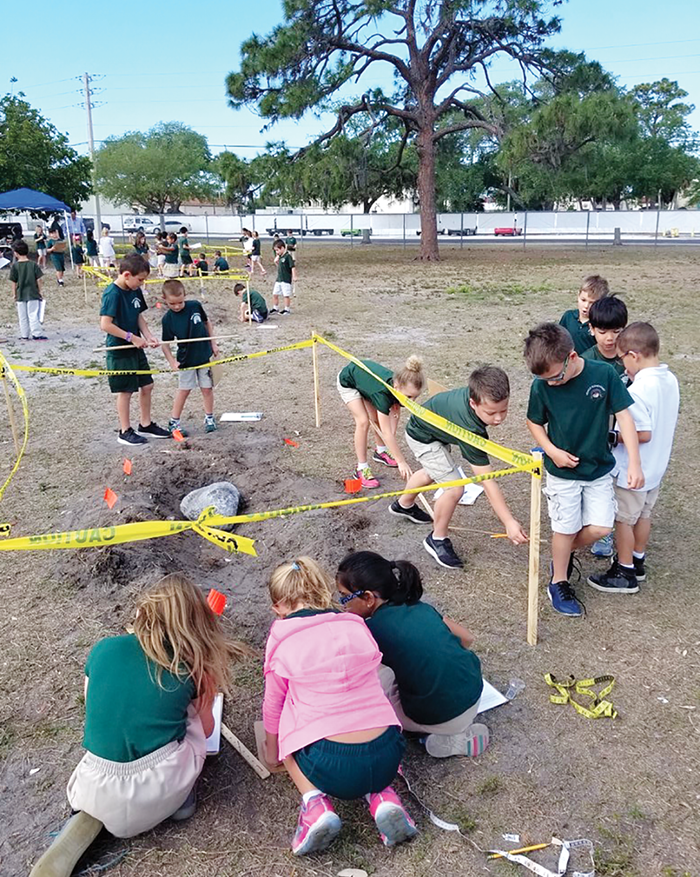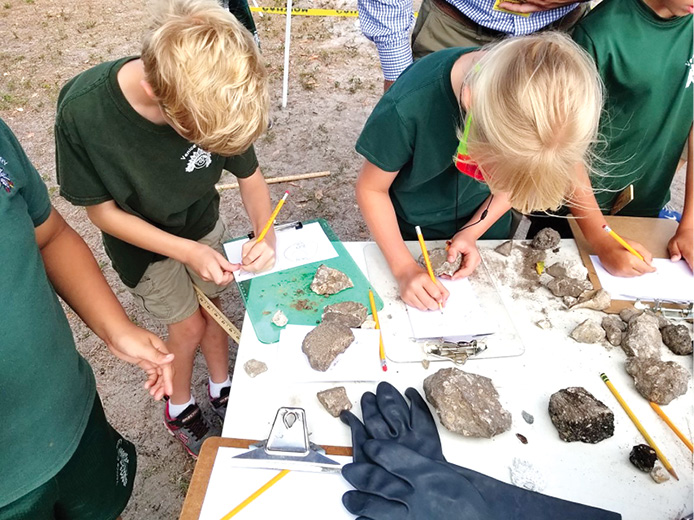cross-curricular connections
A “Meteor” Crashed Into Our School!
Engaging children in science with an immersive scenario
Science and Children—January/February 2022 (Volume 59, Issue 3)
By Dana Zeidler, Mitch Ruzek, and Melanie Kinskey
Preparation and Pre-Immersion Site Setup
This “full scale” immersive scenario format relies on coordination and cooperation of building maintenance professionals, administration, landscape companies, and teacher leaders.
Site setup is accomplished either the weekend preceding the immersion or the last school day prior to the immersive week. It is important that this is done when students are not aware of what is happening and allows for a novel discovery experience during the “Day of Discovery.” Site preparation happens in the following main themes and is open to artistic expression and dependent on campus geography.
Impact Crater: The impact crater is ultimately determined by the size of the boulder or boulders and is dug by the landscaper or contractor delivering the boulder. Often district facilities either help facilitate this or in some cases take over the digging prep once the boulder is delivered. The crater should comfortably house at least 1/3 of the boulder depth. It is beneficial if some of the boulder is protruding for analysis and visual observation. The crater should not be deeper than the boulder is high for both safety and visual effect.
Impact Streak or Drag Mark: Leading away from the boulder, a drag mark should be made disrupting the soil to insinuate that the meteor impacted at an appropriate angle or trajectory. This streak need not be too deep and should be at least 4’–5’ in length. Bouncing allusions, multiple impact streaks, or similar additions can be made depending on how ambitious the setup is.
Boulder: Any landscape rock or similar boulder roughly 3’–5’ or larger will suffice. A boulder that is “exotic” or not recognized as natural statewide or regional stone is preferred. If a naturally occurring stone is all that is available, paint or similar discoloration techniques have successfully been used in the past to enhance the appearance. Often, karst, a limestone type of boulder, mimics many characteristics of a meteor quite well.
Scientific and Academic Instruments: Age-appropriate instruments familiar to the students should be displayed at the impact site as desired. Measuring tape, scales, collection tubes, magnifying glasses, etc., enhance the approachability of the scenario. The more the students can identify with the instruments, the more educationally impactful the experience becomes. What would your students use to collect more data, answer questions, or record observations? Remember, this is not limited to science.
NASA Characters: The NASA characters can be members of staff who are unfamiliar to the students or volunteers. The role of the NASA characters is to guide inquiry, encourage proper scientific reasoning, support skepticism, and model proper technique and vocabulary. This can be fun and provides great photo ops for student reporters.
As buses and carpools dispatched their young charges, something was definitely amiss on the elementary school grounds. On this clear bright day, an astonishing discovery was observed. Students were confronted by the site of “NASA scientists” in full containment gear working behind taped off sections of the school’s common field recording information and surveying the site. It appeared that a “meteor” had crashed into the grounds sometime the previous night, as the debris field stretching a distance of 75 meters consisting of 25-pound rock fragments, skid marks, and the large unexplained 1500-pound exotic rock protruding from a large crater suggested. This certainly presented an interesting and engaging phenomenon to be investigated!
“I heard it last night!” shouted one small boy in quite an animated tone. “I heard it too!!” exclaimed the little girl next to him, wanting to share in the newfound discovery. The children would spend the better part of that week addressing the many surprising questions related to this event.

Background
Our goal was to provide a sociocultural context for inquiry through the use of immersive academic scenarios. In doing so, we provided the opportunity to participate in real-world simulations that mimic the way science and the humanities are naturally intertwined. While full immersion or participation is the goal, the week’s interaction time at the impact site was completely determined by individual teachers or classroom needs.
Immersive scenario is a novel term we created to encapsulate the complete academic and social experience that is exemplified by one of these dramatically themed teachable events. More specifically, we drew on the socioscientific issues framework (SSI), which is aligned with a sociocultural view of science education and offers documented outcomes of student learning, including increased cognitive and moral development, understanding of scientific concepts and nature of science, character development, perspective-taking, and empathy (Kahn and Zeidler 2016; Mueller and Tippins 2015; Roberts and Bybee 2014; Zeidler 2014; Zeidler, Herman, and Sadler 2019).
Working in conjunction with the Education Foundation of Sarasota County, Florida, our immersive academic approach mirrors their creed that education is meant to change lives, allowing children to reach the full expression of their educative potential. Accordingly, our method of instruction is grounded in authentic inquiry designed to meet the developmental needs of elementary children by connecting science, the creative arts, social sciences, language arts, and other domains central to human understanding. Our interdisciplinary, guided inquiry approach to this immersive science experience has been a model for providing equitable science instruction to students of varying cultures and English language learners (ELL). Through the connection of science and language arts, ELL students were provided opportunities to improve their academic vocabulary in an authentic way. The use of mathematical tools and inquiry-based learning allowed students with exceptionalities to have scaffolds as they explored their wonderings connected to this scientific phenomenon. During the moments of being immersed in this experience, all students were brought together regardless of race, ethnicity, gender, language, or developmental level—their common denominator was threefold: wonderment, curiosity, and excitement!
Overview of Immersive Event
During Day 1, the students observed an impact streak, or drag mark, leading away from the boulder in a direction that was opposite the main building or central campus. With the immersive scenario pedagogy and preplanned curricular material in place, students were ready to encounter and discover many scripted and serendipitous aspects of this meteoric impact. The drag mark disrupted the soil to insinuate that the meteor impacted the Earth at an angle. The students were to “discover” the event much in the way actual scientific discoveries transpire in real time. Following the morning bell, classes were allowed scheduled time during the day to access the site and interact with NASA characters (professors). As students came out to the site, their teachers and other adults escorted them to ensure their safety. The children naturally and without prompting observed, raised questions, and developed inquiry plans as to the best way to investigate this finding in subsequent days. Students approached the site with pre-planned journals, observation sheets, or other pre-immersion initiatives. Mostly, students were encouraged to ask questions and offer tentative explanations, observations and inferences. The first day serves to immerse the students in the scenario. Students’ comments range from shock and surprise to inquiry and observation. Examples of Day 1 student quotes included: “The rock has lines and holes. Do rocks have holes? Are they moon rocks?” “Two (meteors) came from different directions and smashed into each other, broke, and landed here!” “It’s a crater! Look at the smoke!” “It’s huge!” and, “This is so crazy!”

Throughout Days 2–4, students were permitted to interact with the impact site, raise new questions, make measurements, dig for pre-planted and naturally occurring specimens (e.g., students found other objects that were buried in the ground from previous construction, found fossils, recorded observations, and practiced a range of inquiry skills). As students dug for additional specimens, protective gloves, goggles, and small shovels were provided. If a student wanted to further explore a piece of the meteorite that was behind the roped off area, NASA characters were able to retrieve the specimen and bring it to a worktable where the students could safely record observations such as circumference, length, height, and mass. It was quite easy to incorporate rock and mineral identification, classification schemes, and local fossil specimens conveniently unearthed by the meteor. In this manner, the site was conducive to exploring varied interests of teachers and students from different classrooms. The NASA characters also visited many individual classrooms and further encouraged students to test ideas, generate hypotheses, create drawings, and share reports. Throughout the week, teachers formatively assessed student understandings of the science content. Students also compared and contrasted specimens they observed with a T-chart or wrote one-page articles describing the impact. When visiting teachers and their students in classrooms, we focused on modeling best pedagogical practices for guided inquiry to cultivate scientific habits of mind in students. For the K–5 students, these included:
- Curiosity
- Openness to New Ideas
- Informed Skepticism
- Dealing with Ambiguity
- Taking Risks to Generate New Ideas
News reports were given on the school’s morning TV announcements about new discoveries made by different classes and updates from the scientists. Enthusiasm was palpable for all the K–5 classes throughout the entire week. Some students were so excited that they chose to spend their recess continuing their inquiries.
Day 5 was one of reflection and celebration. Students were invited to share their drawings and major findings with other classes by building a communal hallway of science discoveries. Students were prompted to recap their main findings and most interesting observations with one another and among classes. During the end of lunch periods, each grade was brought out to the excavation site, a model of the meteor was given to the principal—who would showcase it to commemorate the week the meteor came to their school—and moon-pies were distributed, much to the delight of both students and their teachers!
Interdisciplinary Connections
Science
Students were normally allowed unstructured recess to “play” after lunch. Instead, most chose to visit the scientists monitoring the impact site and continue to record observations and draw pictures. Additionally, an investigation table of clipboards with paper, safety goggles, measuring tapes, sample rocks, artifacts, and gloves were always present at the site. Students were instructed on proper investigation safety during their initial supervised site visits. This unstructured access provided students with a sense of ownership over their investigations through authentic scientific discovery. Recorded observations, written notations, as well as diagrams and pictures drawn were used in conjunction with other assessment material collected during the week to better gauge student content and conceptual understanding during the week. When we asked if we could see some of their drawings, a few caught our attention. One student drew a picture of herself as a scientist observing the site! We were well pleased to see a sense of science identity taking hold. Other unplanned investigations were carried out during lunchtime. For instance, students decided to bring magnets out to the site and perform tests on different parts of the meteor and smaller samples. Much to our surprise, they found sections containing traces of magnetism! Data was recorded and careful drawings made to share with their classmates after lunch.
We aimed to generate discussions based on students’ observations. One fourth-grade student surprised us, as he seemed to grasp a fundamental tenant of the nature of science. In explaining how the smaller and larger chunks of rock could have made particular marks and impacts, he stated that he had two “theories” that could explain the observed event, and he provided evidence for each idea. One was having the meteor break up just before hitting the field and creating multiple holes simultaneously; the other competing idea was that the meteor had hit the ground and subsequently broken apart with different pieces embedding themselves in the ground and repeating that process until the final large crater was formed.

Physical Education and Math
The physical education teacher brought one of his classes out to the site and challenged the students to create ways to measure or estimate the size, weight, and other dimensions associated with the meteor impact site with limited instruments. Students did not hesitate to lay head to feet to measure and record data, and then measure themselves later to make the necessary conversions. This became an excellent opportunity to explore non-standard units of measurement and convert them to standard units of measurement. Mathematics lessons on proportions, circumference, weight, and volume were also used to connect to this event.
Language Arts/Social Studies/Arts
These immersive scenarios are by no means limited to science-exclusive domains. Updated news reports were written, and the student news station interviewed the scientists reporting new discoveries from different classes on the morning TV school news station. Each grade level created artwork illustrating student renderings of the site. Historical lessons on sightings of past comets were pursued in classrooms. Language arts connections were made as students crafted scientific reports each day.
The high school shared common ground with the elementary school, and some high school teachers participated in the development of this event and brainstormed how high school students could be involved. One teacher used the immersive event to bring her high school class out to the impact site and lead a discussion of how Shakespeare, the Church, and scientists such as Galileo would have interpreted this event had the comet been found in the middle of the Globe Theatre. This prompted the scientists to join in subsequent SSI discussions that ranged from karma versus free will as to whether people are smarter and more creative now than in Shakespeare’s time. Further serendipity was to be found when several older students informed younger siblings later in the week that the meteor was not “real.” This allowed us to broach the idea of exhibiting healthy skepticism and leading elementary students to raise questions about how to examine evidence in different ways. When students might ask us directly if the meteor was real, we let the students discuss what is similar or different about their sample versus what sources reported about actual meteors. Hence, students were never directly told that the meteor is “fake” or “not real.” Rather, we told them that we needed their help in determining the characteristics of the “object,” and they were encouraged to use their own powers of observation and deduction to provide explanations about the phenomena in a way that they could defend their viewpoints with logic and evidence-based discourse. Oftentimes, students displayed the ability to harbor two incongruent but supported conclusions that they are capable of presenting and defending. We were particularly happy to witness this as handling ambiguity and evaluating evidence, coupled with healthy skepticism, is paramount to scientific literacy. Actual quotes from K–5 students filled the spectrum and included many creative ideas such as: “You could analyze particles on the rock for DNA to see if it came from space.” “We could all take magnets and see if it’s magnetic since meteors are magnetic.” “The holes are from it falling down.” “I did some research. The crater isn’t big enough to be a real meteorite.” “Maybe it’s fake and there is foam in the middle with rock painted on the outside.” Curiosity and wonderment are the first step of framing scientific ideas and investigations.
Conclusion
Merging informal science education experiences, such as this simulation, with formal classroom instruction can provide a viable means to tap the natural curiosity and sense of wonder that children instinctively bring to school every day. Our work demonstrated the excitement that can be generated schoolwide in K–5 education when teachers feel supported to step out of the safety zone of a prescribed curriculum and allow interdisciplinary connections to organically arise. In fact, many of the concepts typically covered in a prescribed curriculum can be easily crafted into informal contexts where teachers, much like our young science students, are encouraged to take risks and “trust the process!” Given the opportunity, children can create their own investigations, raise interesting and unanticipated questions and with a little guidance, enact important scientific habits of mind that can live fruitfully in future experiences.
Online Resource
Immersive Academics
https://immersiveacademicsedu.com
Dana Zeidler (zeidler@usf.edu) is a distinguished university professor of science education, and Mitch Ruzek is an adjunct professor of science education, both at the University of South Florida in Tampa, Florida. Melanie Kinskey is an assistant professor of science education at Sam Houston State University in Huntsville, Texas.
Crosscutting Concepts Instructional Materials Interdisciplinary


